Corporate Finance Report: FedEx Capital Structure Analysis 2013-2018
VerifiedAdded on 2020/10/22
|28
|6957
|131
Report
AI Summary
This report provides a comprehensive analysis of FedEx Corporation's capital structure from 2013 to 2018, focusing on its financing through debt and its implications. The report explores key concepts in corporate finance, including capital structure, Weighted Average Cost of Capital (WACC), and the impact of dividend payments on share prices. It examines the relationship between financial leverage, cost of equity, and tax benefits associated with debt. The analysis incorporates various scholarly perspectives on dividend policy, highlighting its signaling impact on investors and its influence on stock prices. The report also considers factors such as financial leverage, tax rates, and asset performance. The report offers insights into how dividend decisions affect a company's financial performance, market liquidity, and overall shareholder value. It also addresses the influence of external factors such as trade location and ownership on stock prices. This report is valuable for students and professionals seeking a deeper understanding of corporate finance and its practical applications.
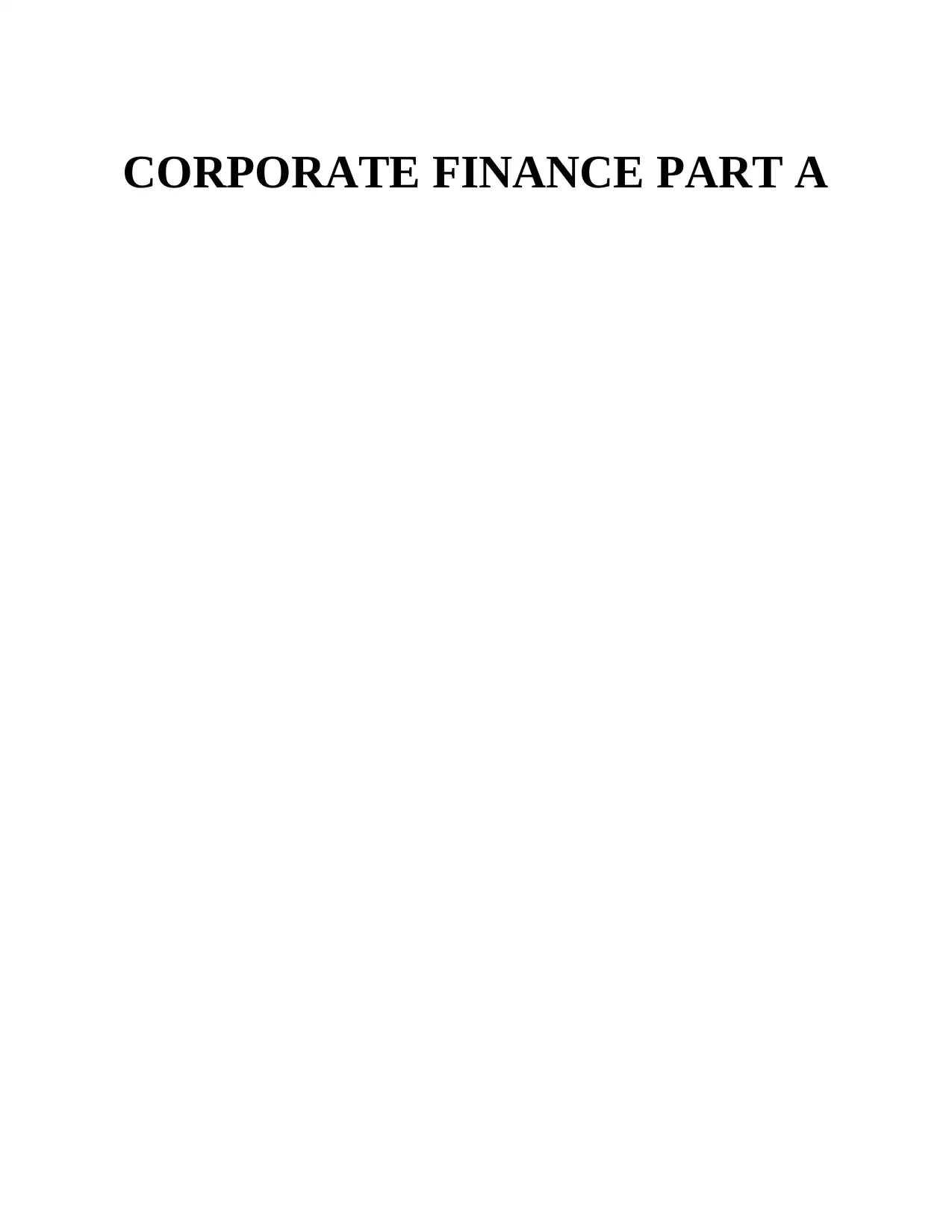
CORPORATE FINANCE PART A
Paraphrase This Document
Need a fresh take? Get an instant paraphrase of this document with our AI Paraphraser
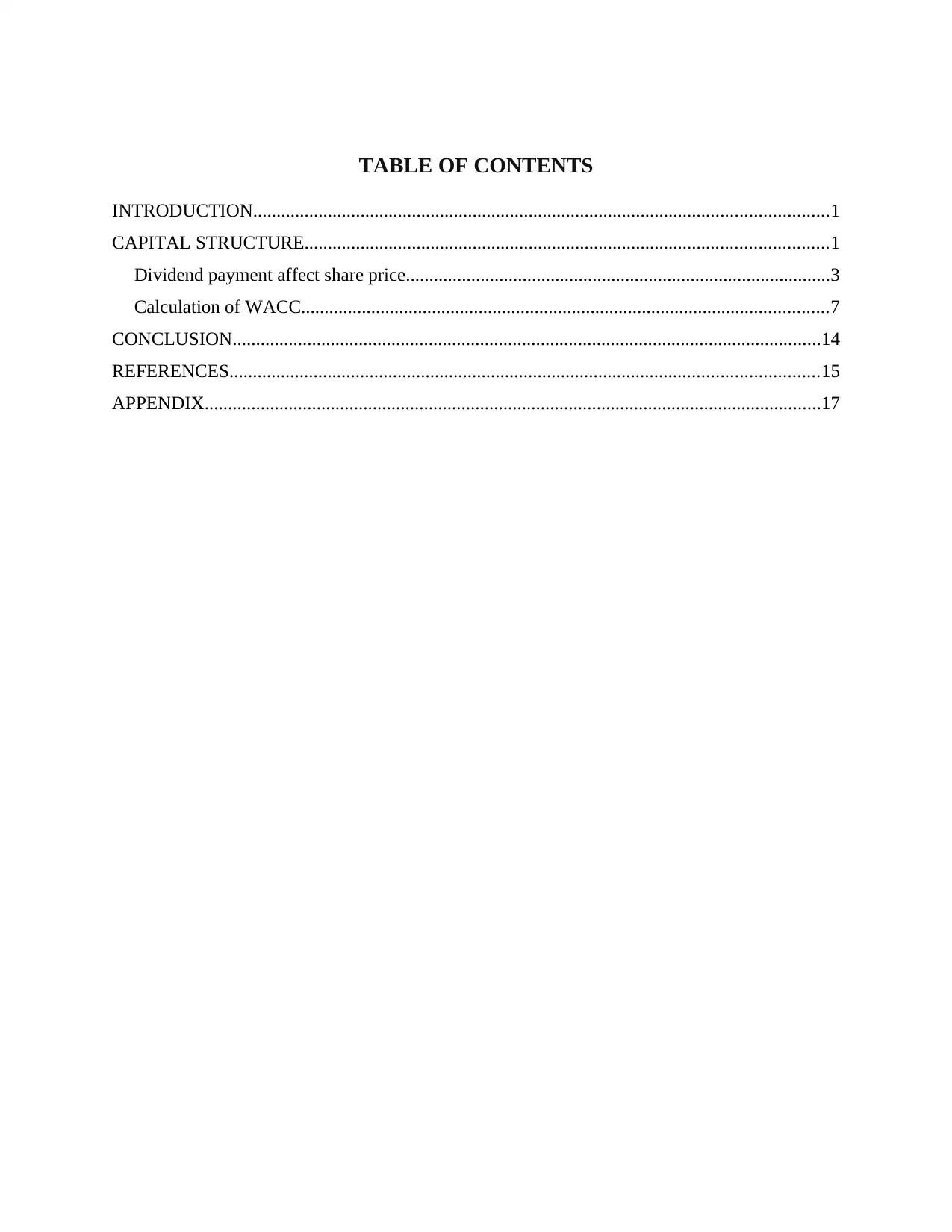
TABLE OF CONTENTS
INTRODUCTION...........................................................................................................................1
CAPITAL STRUCTURE................................................................................................................1
Dividend payment affect share price...........................................................................................3
Calculation of WACC.................................................................................................................7
CONCLUSION..............................................................................................................................14
REFERENCES..............................................................................................................................15
APPENDIX....................................................................................................................................17
INTRODUCTION...........................................................................................................................1
CAPITAL STRUCTURE................................................................................................................1
Dividend payment affect share price...........................................................................................3
Calculation of WACC.................................................................................................................7
CONCLUSION..............................................................................................................................14
REFERENCES..............................................................................................................................15
APPENDIX....................................................................................................................................17

INTRODUCTION
Corporate finance is referred as branch of finance which directly deals for sources of
funding, capital structure of particular corporations and actions which manager undertakes for
raising value of firm to the shareholders along with tool and analysis which is used for analysis
for allocating financial resources. The capital structure is referred as proportion along with
combination of equity share capital, debentures, preference share capital, long term loans and
retained earnings. In simple words, it finances overall operation and growth with application of
different sources of funds. Debt originates in form of issuing bond or long term notes payable
where equity is classified as preferred stock, retained earnings or common stock. The present
report is about FedEx Corporation between 2013-2018 along with remarkable changes in last 5
years as it is dramatically financed through debt. This report has evaluated WACC along with
obtaining optimal capital structure with reference to FedEx Corporations.
CAPITAL STRUCTURE
(Listed in Appendix)
Illustration 1: Capital structure of FedEx Corporations
1
Corporate finance is referred as branch of finance which directly deals for sources of
funding, capital structure of particular corporations and actions which manager undertakes for
raising value of firm to the shareholders along with tool and analysis which is used for analysis
for allocating financial resources. The capital structure is referred as proportion along with
combination of equity share capital, debentures, preference share capital, long term loans and
retained earnings. In simple words, it finances overall operation and growth with application of
different sources of funds. Debt originates in form of issuing bond or long term notes payable
where equity is classified as preferred stock, retained earnings or common stock. The present
report is about FedEx Corporation between 2013-2018 along with remarkable changes in last 5
years as it is dramatically financed through debt. This report has evaluated WACC along with
obtaining optimal capital structure with reference to FedEx Corporations.
CAPITAL STRUCTURE
(Listed in Appendix)
Illustration 1: Capital structure of FedEx Corporations
1
⊘ This is a preview!⊘
Do you want full access?
Subscribe today to unlock all pages.

Trusted by 1+ million students worldwide
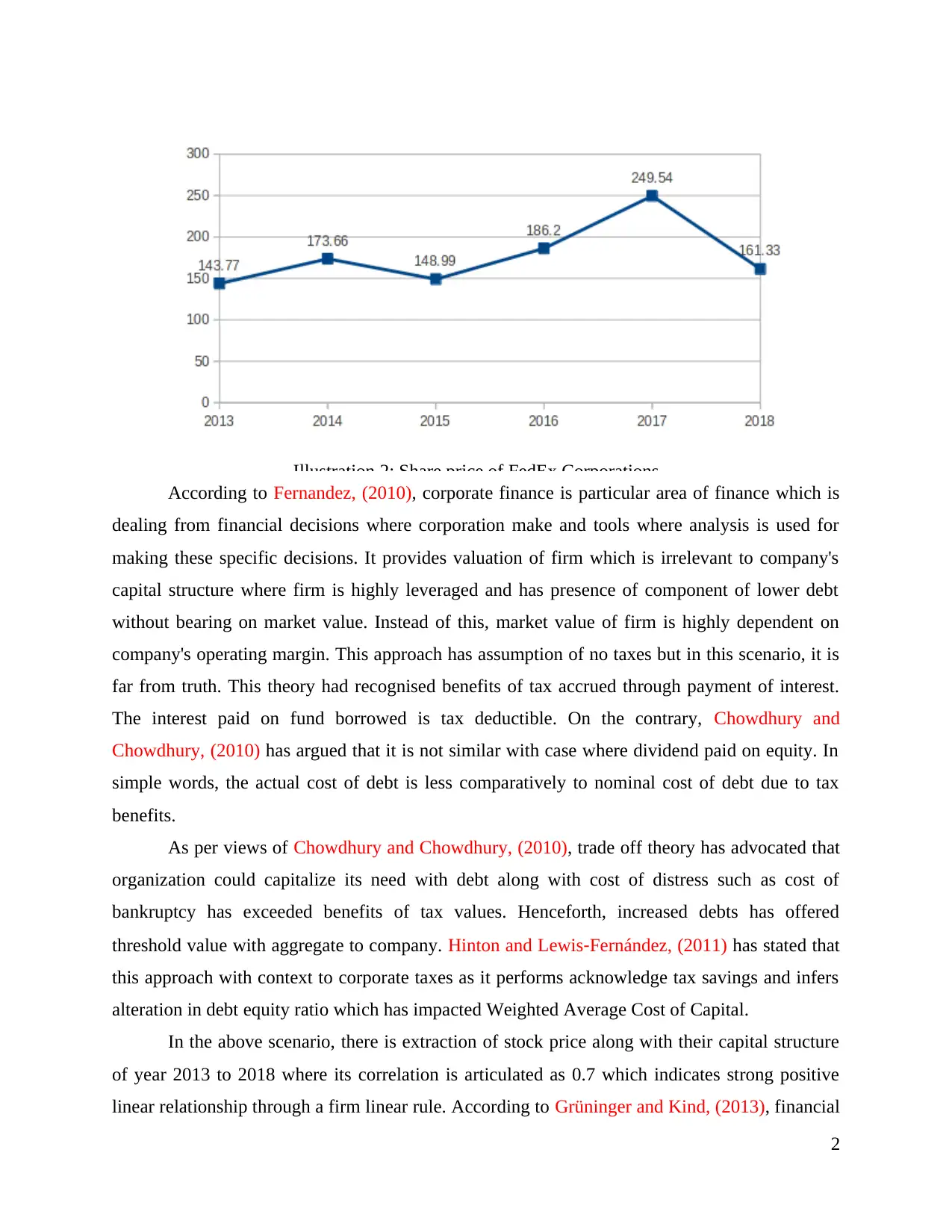
Illustration 2: Share price of FedEx Corporations
According to Fernandez, (2010), corporate finance is particular area of finance which is
dealing from financial decisions where corporation make and tools where analysis is used for
making these specific decisions. It provides valuation of firm which is irrelevant to company's
capital structure where firm is highly leveraged and has presence of component of lower debt
without bearing on market value. Instead of this, market value of firm is highly dependent on
company's operating margin. This approach has assumption of no taxes but in this scenario, it is
far from truth. This theory had recognised benefits of tax accrued through payment of interest.
The interest paid on fund borrowed is tax deductible. On the contrary, Chowdhury and
Chowdhury, (2010) has argued that it is not similar with case where dividend paid on equity. In
simple words, the actual cost of debt is less comparatively to nominal cost of debt due to tax
benefits.
As per views of Chowdhury and Chowdhury, (2010), trade off theory has advocated that
organization could capitalize its need with debt along with cost of distress such as cost of
bankruptcy has exceeded benefits of tax values. Henceforth, increased debts has offered
threshold value with aggregate to company. Hinton and Lewis‐Fernández, (2011) has stated that
this approach with context to corporate taxes as it performs acknowledge tax savings and infers
alteration in debt equity ratio which has impacted Weighted Average Cost of Capital.
In the above scenario, there is extraction of stock price along with their capital structure
of year 2013 to 2018 where its correlation is articulated as 0.7 which indicates strong positive
linear relationship through a firm linear rule. According to Grüninger and Kind, (2013), financial
2
According to Fernandez, (2010), corporate finance is particular area of finance which is
dealing from financial decisions where corporation make and tools where analysis is used for
making these specific decisions. It provides valuation of firm which is irrelevant to company's
capital structure where firm is highly leveraged and has presence of component of lower debt
without bearing on market value. Instead of this, market value of firm is highly dependent on
company's operating margin. This approach has assumption of no taxes but in this scenario, it is
far from truth. This theory had recognised benefits of tax accrued through payment of interest.
The interest paid on fund borrowed is tax deductible. On the contrary, Chowdhury and
Chowdhury, (2010) has argued that it is not similar with case where dividend paid on equity. In
simple words, the actual cost of debt is less comparatively to nominal cost of debt due to tax
benefits.
As per views of Chowdhury and Chowdhury, (2010), trade off theory has advocated that
organization could capitalize its need with debt along with cost of distress such as cost of
bankruptcy has exceeded benefits of tax values. Henceforth, increased debts has offered
threshold value with aggregate to company. Hinton and Lewis‐Fernández, (2011) has stated that
this approach with context to corporate taxes as it performs acknowledge tax savings and infers
alteration in debt equity ratio which has impacted Weighted Average Cost of Capital.
In the above scenario, there is extraction of stock price along with their capital structure
of year 2013 to 2018 where its correlation is articulated as 0.7 which indicates strong positive
linear relationship through a firm linear rule. According to Grüninger and Kind, (2013), financial
2
Paraphrase This Document
Need a fresh take? Get an instant paraphrase of this document with our AI Paraphraser
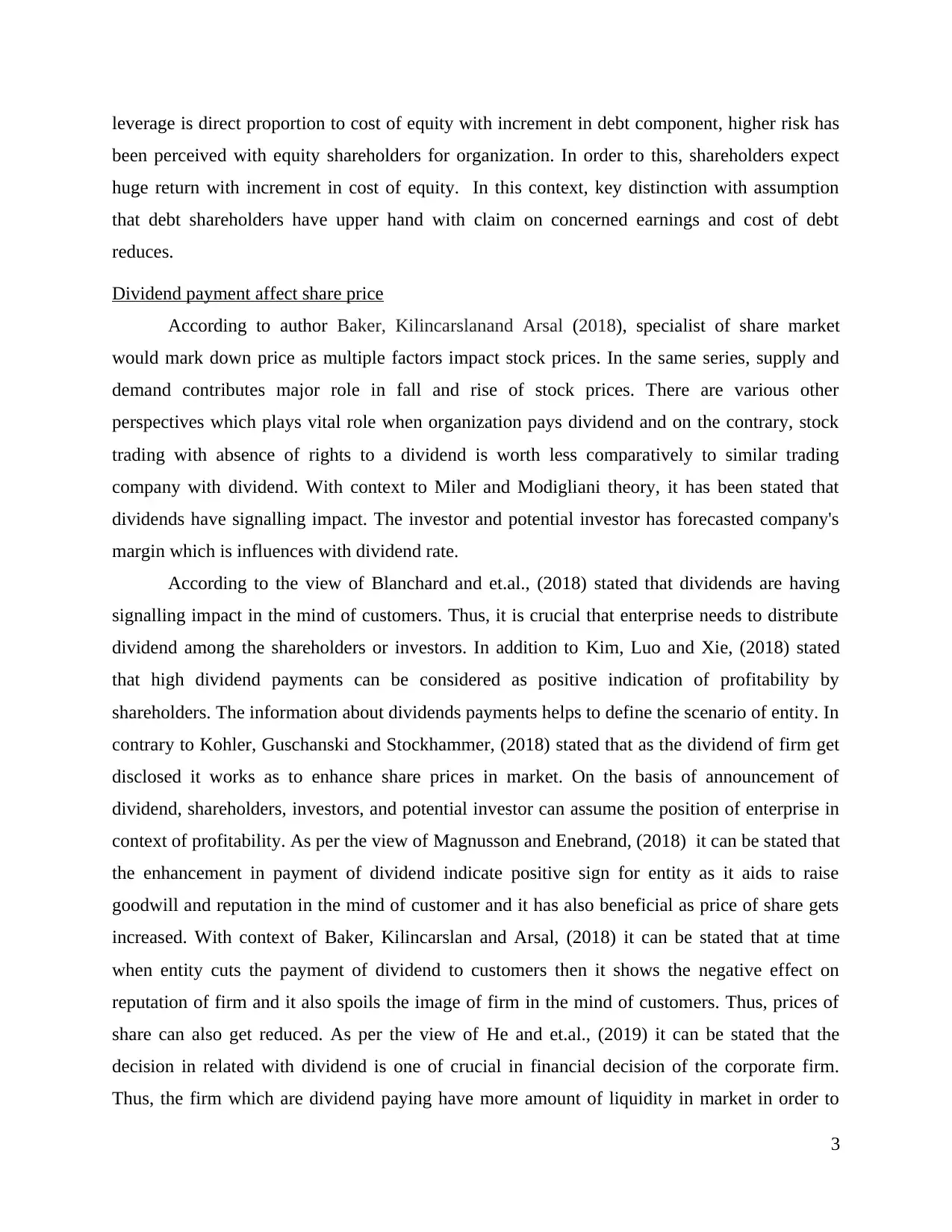
leverage is direct proportion to cost of equity with increment in debt component, higher risk has
been perceived with equity shareholders for organization. In order to this, shareholders expect
huge return with increment in cost of equity. In this context, key distinction with assumption
that debt shareholders have upper hand with claim on concerned earnings and cost of debt
reduces.
Dividend payment affect share price
According to author Baker, Kilincarslanand Arsal (2018), specialist of share market
would mark down price as multiple factors impact stock prices. In the same series, supply and
demand contributes major role in fall and rise of stock prices. There are various other
perspectives which plays vital role when organization pays dividend and on the contrary, stock
trading with absence of rights to a dividend is worth less comparatively to similar trading
company with dividend. With context to Miler and Modigliani theory, it has been stated that
dividends have signalling impact. The investor and potential investor has forecasted company's
margin which is influences with dividend rate.
According to the view of Blanchard and et.al., (2018) stated that dividends are having
signalling impact in the mind of customers. Thus, it is crucial that enterprise needs to distribute
dividend among the shareholders or investors. In addition to Kim, Luo and Xie, (2018) stated
that high dividend payments can be considered as positive indication of profitability by
shareholders. The information about dividends payments helps to define the scenario of entity. In
contrary to Kohler, Guschanski and Stockhammer, (2018) stated that as the dividend of firm get
disclosed it works as to enhance share prices in market. On the basis of announcement of
dividend, shareholders, investors, and potential investor can assume the position of enterprise in
context of profitability. As per the view of Magnusson and Enebrand, (2018) it can be stated that
the enhancement in payment of dividend indicate positive sign for entity as it aids to raise
goodwill and reputation in the mind of customer and it has also beneficial as price of share gets
increased. With context of Baker, Kilincarslan and Arsal, (2018) it can be stated that at time
when entity cuts the payment of dividend to customers then it shows the negative effect on
reputation of firm and it also spoils the image of firm in the mind of customers. Thus, prices of
share can also get reduced. As per the view of He and et.al., (2019) it can be stated that the
decision in related with dividend is one of crucial in financial decision of the corporate firm.
Thus, the firm which are dividend paying have more amount of liquidity in market in order to
3
been perceived with equity shareholders for organization. In order to this, shareholders expect
huge return with increment in cost of equity. In this context, key distinction with assumption
that debt shareholders have upper hand with claim on concerned earnings and cost of debt
reduces.
Dividend payment affect share price
According to author Baker, Kilincarslanand Arsal (2018), specialist of share market
would mark down price as multiple factors impact stock prices. In the same series, supply and
demand contributes major role in fall and rise of stock prices. There are various other
perspectives which plays vital role when organization pays dividend and on the contrary, stock
trading with absence of rights to a dividend is worth less comparatively to similar trading
company with dividend. With context to Miler and Modigliani theory, it has been stated that
dividends have signalling impact. The investor and potential investor has forecasted company's
margin which is influences with dividend rate.
According to the view of Blanchard and et.al., (2018) stated that dividends are having
signalling impact in the mind of customers. Thus, it is crucial that enterprise needs to distribute
dividend among the shareholders or investors. In addition to Kim, Luo and Xie, (2018) stated
that high dividend payments can be considered as positive indication of profitability by
shareholders. The information about dividends payments helps to define the scenario of entity. In
contrary to Kohler, Guschanski and Stockhammer, (2018) stated that as the dividend of firm get
disclosed it works as to enhance share prices in market. On the basis of announcement of
dividend, shareholders, investors, and potential investor can assume the position of enterprise in
context of profitability. As per the view of Magnusson and Enebrand, (2018) it can be stated that
the enhancement in payment of dividend indicate positive sign for entity as it aids to raise
goodwill and reputation in the mind of customer and it has also beneficial as price of share gets
increased. With context of Baker, Kilincarslan and Arsal, (2018) it can be stated that at time
when entity cuts the payment of dividend to customers then it shows the negative effect on
reputation of firm and it also spoils the image of firm in the mind of customers. Thus, prices of
share can also get reduced. As per the view of He and et.al., (2019) it can be stated that the
decision in related with dividend is one of crucial in financial decision of the corporate firm.
Thus, the firm which are dividend paying have more amount of liquidity in market in order to
3
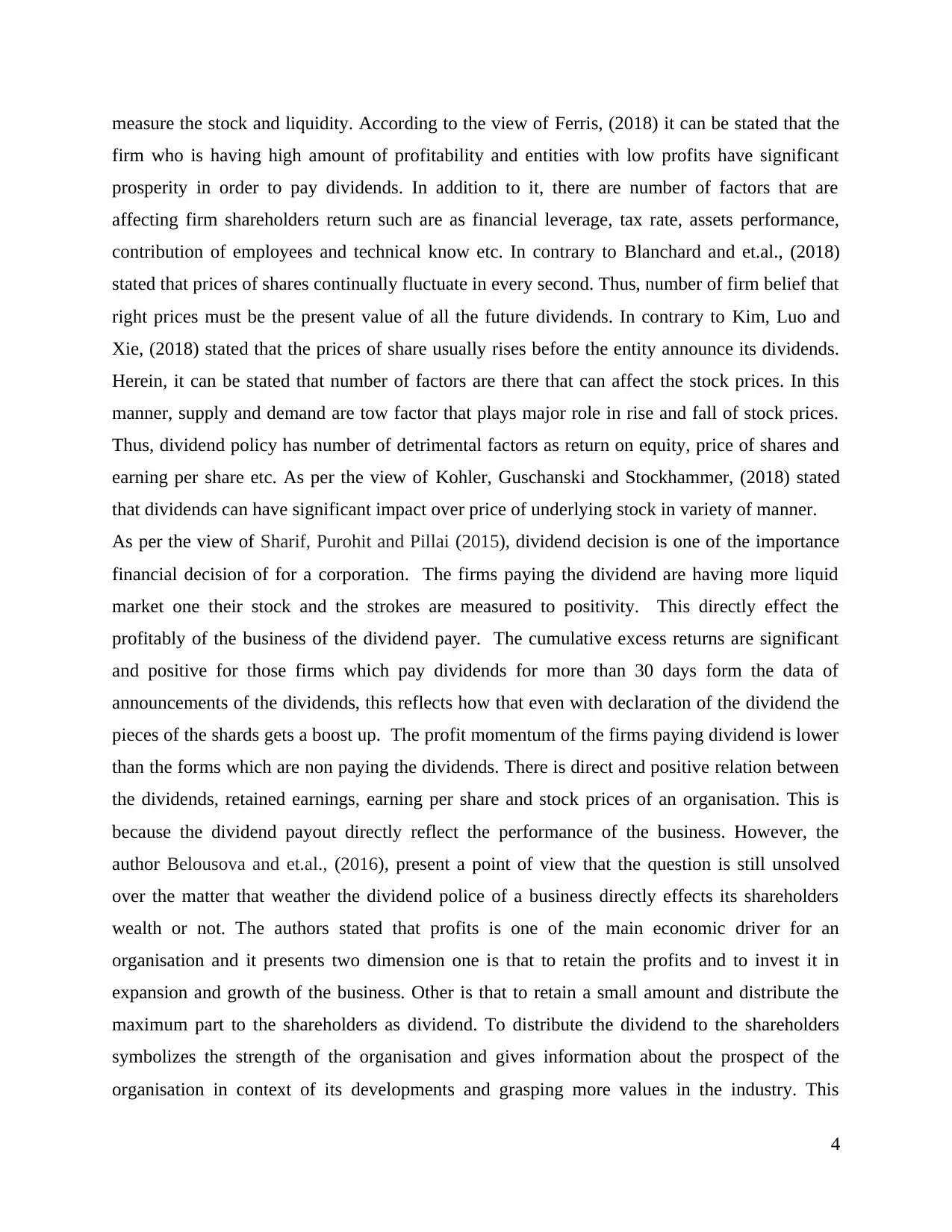
measure the stock and liquidity. According to the view of Ferris, (2018) it can be stated that the
firm who is having high amount of profitability and entities with low profits have significant
prosperity in order to pay dividends. In addition to it, there are number of factors that are
affecting firm shareholders return such are as financial leverage, tax rate, assets performance,
contribution of employees and technical know etc. In contrary to Blanchard and et.al., (2018)
stated that prices of shares continually fluctuate in every second. Thus, number of firm belief that
right prices must be the present value of all the future dividends. In contrary to Kim, Luo and
Xie, (2018) stated that the prices of share usually rises before the entity announce its dividends.
Herein, it can be stated that number of factors are there that can affect the stock prices. In this
manner, supply and demand are tow factor that plays major role in rise and fall of stock prices.
Thus, dividend policy has number of detrimental factors as return on equity, price of shares and
earning per share etc. As per the view of Kohler, Guschanski and Stockhammer, (2018) stated
that dividends can have significant impact over price of underlying stock in variety of manner.
As per the view of Sharif, Purohit and Pillai (2015), dividend decision is one of the importance
financial decision of for a corporation. The firms paying the dividend are having more liquid
market one their stock and the strokes are measured to positivity. This directly effect the
profitably of the business of the dividend payer. The cumulative excess returns are significant
and positive for those firms which pay dividends for more than 30 days form the data of
announcements of the dividends, this reflects how that even with declaration of the dividend the
pieces of the shards gets a boost up. The profit momentum of the firms paying dividend is lower
than the forms which are non paying the dividends. There is direct and positive relation between
the dividends, retained earnings, earning per share and stock prices of an organisation. This is
because the dividend payout directly reflect the performance of the business. However, the
author Belousova and et.al., (2016), present a point of view that the question is still unsolved
over the matter that weather the dividend police of a business directly effects its shareholders
wealth or not. The authors stated that profits is one of the main economic driver for an
organisation and it presents two dimension one is that to retain the profits and to invest it in
expansion and growth of the business. Other is that to retain a small amount and distribute the
maximum part to the shareholders as dividend. To distribute the dividend to the shareholders
symbolizes the strength of the organisation and gives information about the prospect of the
organisation in context of its developments and grasping more values in the industry. This
4
firm who is having high amount of profitability and entities with low profits have significant
prosperity in order to pay dividends. In addition to it, there are number of factors that are
affecting firm shareholders return such are as financial leverage, tax rate, assets performance,
contribution of employees and technical know etc. In contrary to Blanchard and et.al., (2018)
stated that prices of shares continually fluctuate in every second. Thus, number of firm belief that
right prices must be the present value of all the future dividends. In contrary to Kim, Luo and
Xie, (2018) stated that the prices of share usually rises before the entity announce its dividends.
Herein, it can be stated that number of factors are there that can affect the stock prices. In this
manner, supply and demand are tow factor that plays major role in rise and fall of stock prices.
Thus, dividend policy has number of detrimental factors as return on equity, price of shares and
earning per share etc. As per the view of Kohler, Guschanski and Stockhammer, (2018) stated
that dividends can have significant impact over price of underlying stock in variety of manner.
As per the view of Sharif, Purohit and Pillai (2015), dividend decision is one of the importance
financial decision of for a corporation. The firms paying the dividend are having more liquid
market one their stock and the strokes are measured to positivity. This directly effect the
profitably of the business of the dividend payer. The cumulative excess returns are significant
and positive for those firms which pay dividends for more than 30 days form the data of
announcements of the dividends, this reflects how that even with declaration of the dividend the
pieces of the shards gets a boost up. The profit momentum of the firms paying dividend is lower
than the forms which are non paying the dividends. There is direct and positive relation between
the dividends, retained earnings, earning per share and stock prices of an organisation. This is
because the dividend payout directly reflect the performance of the business. However, the
author Belousova and et.al., (2016), present a point of view that the question is still unsolved
over the matter that weather the dividend police of a business directly effects its shareholders
wealth or not. The authors stated that profits is one of the main economic driver for an
organisation and it presents two dimension one is that to retain the profits and to invest it in
expansion and growth of the business. Other is that to retain a small amount and distribute the
maximum part to the shareholders as dividend. To distribute the dividend to the shareholders
symbolizes the strength of the organisation and gives information about the prospect of the
organisation in context of its developments and grasping more values in the industry. This
4
⊘ This is a preview!⊘
Do you want full access?
Subscribe today to unlock all pages.

Trusted by 1+ million students worldwide
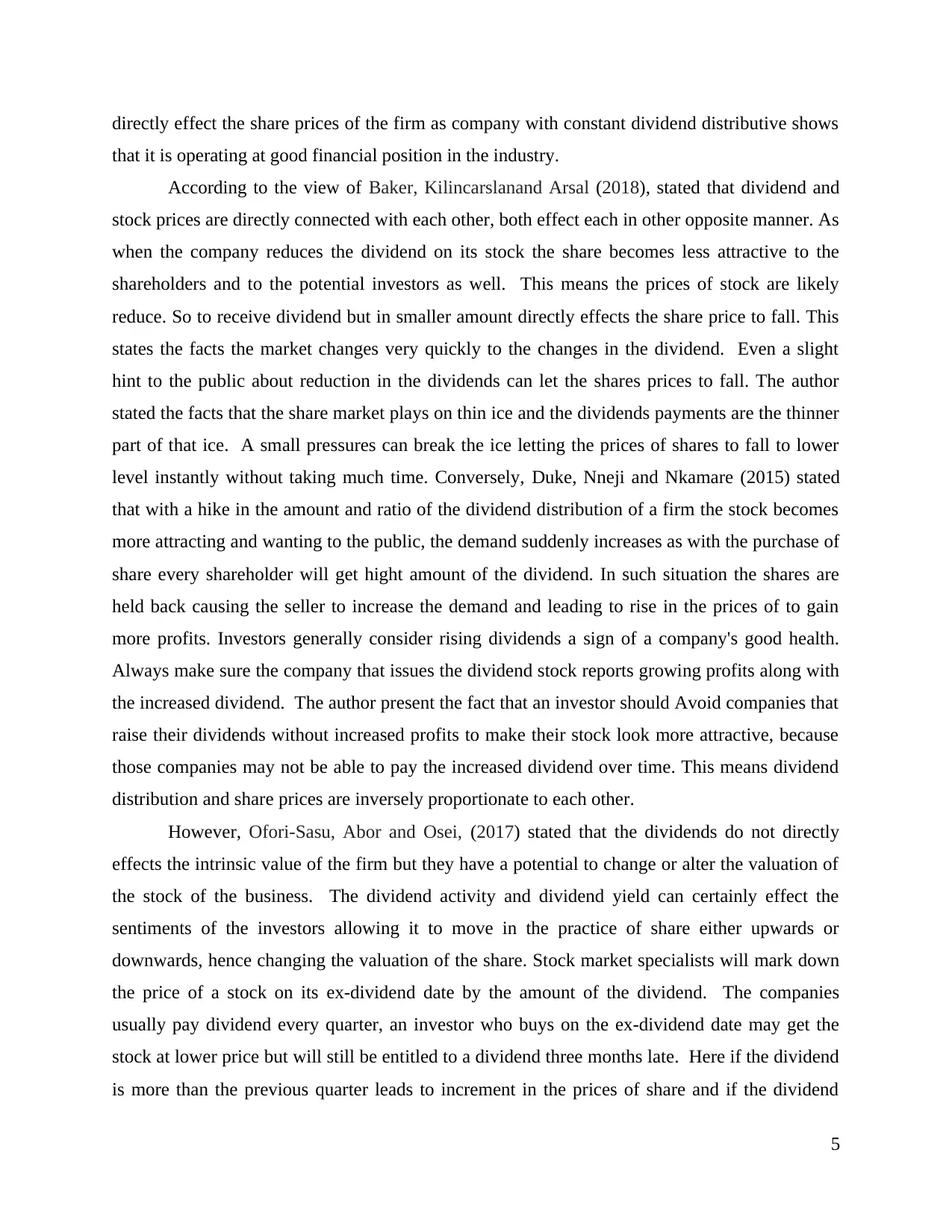
directly effect the share prices of the firm as company with constant dividend distributive shows
that it is operating at good financial position in the industry.
According to the view of Baker, Kilincarslanand Arsal (2018), stated that dividend and
stock prices are directly connected with each other, both effect each in other opposite manner. As
when the company reduces the dividend on its stock the share becomes less attractive to the
shareholders and to the potential investors as well. This means the prices of stock are likely
reduce. So to receive dividend but in smaller amount directly effects the share price to fall. This
states the facts the market changes very quickly to the changes in the dividend. Even a slight
hint to the public about reduction in the dividends can let the shares prices to fall. The author
stated the facts that the share market plays on thin ice and the dividends payments are the thinner
part of that ice. A small pressures can break the ice letting the prices of shares to fall to lower
level instantly without taking much time. Conversely, Duke, Nneji and Nkamare (2015) stated
that with a hike in the amount and ratio of the dividend distribution of a firm the stock becomes
more attracting and wanting to the public, the demand suddenly increases as with the purchase of
share every shareholder will get hight amount of the dividend. In such situation the shares are
held back causing the seller to increase the demand and leading to rise in the prices of to gain
more profits. Investors generally consider rising dividends a sign of a company's good health.
Always make sure the company that issues the dividend stock reports growing profits along with
the increased dividend. The author present the fact that an investor should Avoid companies that
raise their dividends without increased profits to make their stock look more attractive, because
those companies may not be able to pay the increased dividend over time. This means dividend
distribution and share prices are inversely proportionate to each other.
However, Ofori‐Sasu, Abor and Osei, (2017) stated that the dividends do not directly
effects the intrinsic value of the firm but they have a potential to change or alter the valuation of
the stock of the business. The dividend activity and dividend yield can certainly effect the
sentiments of the investors allowing it to move in the practice of share either upwards or
downwards, hence changing the valuation of the share. Stock market specialists will mark down
the price of a stock on its ex-dividend date by the amount of the dividend. The companies
usually pay dividend every quarter, an investor who buys on the ex-dividend date may get the
stock at lower price but will still be entitled to a dividend three months late. Here if the dividend
is more than the previous quarter leads to increment in the prices of share and if the dividend
5
that it is operating at good financial position in the industry.
According to the view of Baker, Kilincarslanand Arsal (2018), stated that dividend and
stock prices are directly connected with each other, both effect each in other opposite manner. As
when the company reduces the dividend on its stock the share becomes less attractive to the
shareholders and to the potential investors as well. This means the prices of stock are likely
reduce. So to receive dividend but in smaller amount directly effects the share price to fall. This
states the facts the market changes very quickly to the changes in the dividend. Even a slight
hint to the public about reduction in the dividends can let the shares prices to fall. The author
stated the facts that the share market plays on thin ice and the dividends payments are the thinner
part of that ice. A small pressures can break the ice letting the prices of shares to fall to lower
level instantly without taking much time. Conversely, Duke, Nneji and Nkamare (2015) stated
that with a hike in the amount and ratio of the dividend distribution of a firm the stock becomes
more attracting and wanting to the public, the demand suddenly increases as with the purchase of
share every shareholder will get hight amount of the dividend. In such situation the shares are
held back causing the seller to increase the demand and leading to rise in the prices of to gain
more profits. Investors generally consider rising dividends a sign of a company's good health.
Always make sure the company that issues the dividend stock reports growing profits along with
the increased dividend. The author present the fact that an investor should Avoid companies that
raise their dividends without increased profits to make their stock look more attractive, because
those companies may not be able to pay the increased dividend over time. This means dividend
distribution and share prices are inversely proportionate to each other.
However, Ofori‐Sasu, Abor and Osei, (2017) stated that the dividends do not directly
effects the intrinsic value of the firm but they have a potential to change or alter the valuation of
the stock of the business. The dividend activity and dividend yield can certainly effect the
sentiments of the investors allowing it to move in the practice of share either upwards or
downwards, hence changing the valuation of the share. Stock market specialists will mark down
the price of a stock on its ex-dividend date by the amount of the dividend. The companies
usually pay dividend every quarter, an investor who buys on the ex-dividend date may get the
stock at lower price but will still be entitled to a dividend three months late. Here if the dividend
is more than the previous quarter leads to increment in the prices of share and if the dividend
5
Paraphrase This Document
Need a fresh take? Get an instant paraphrase of this document with our AI Paraphraser
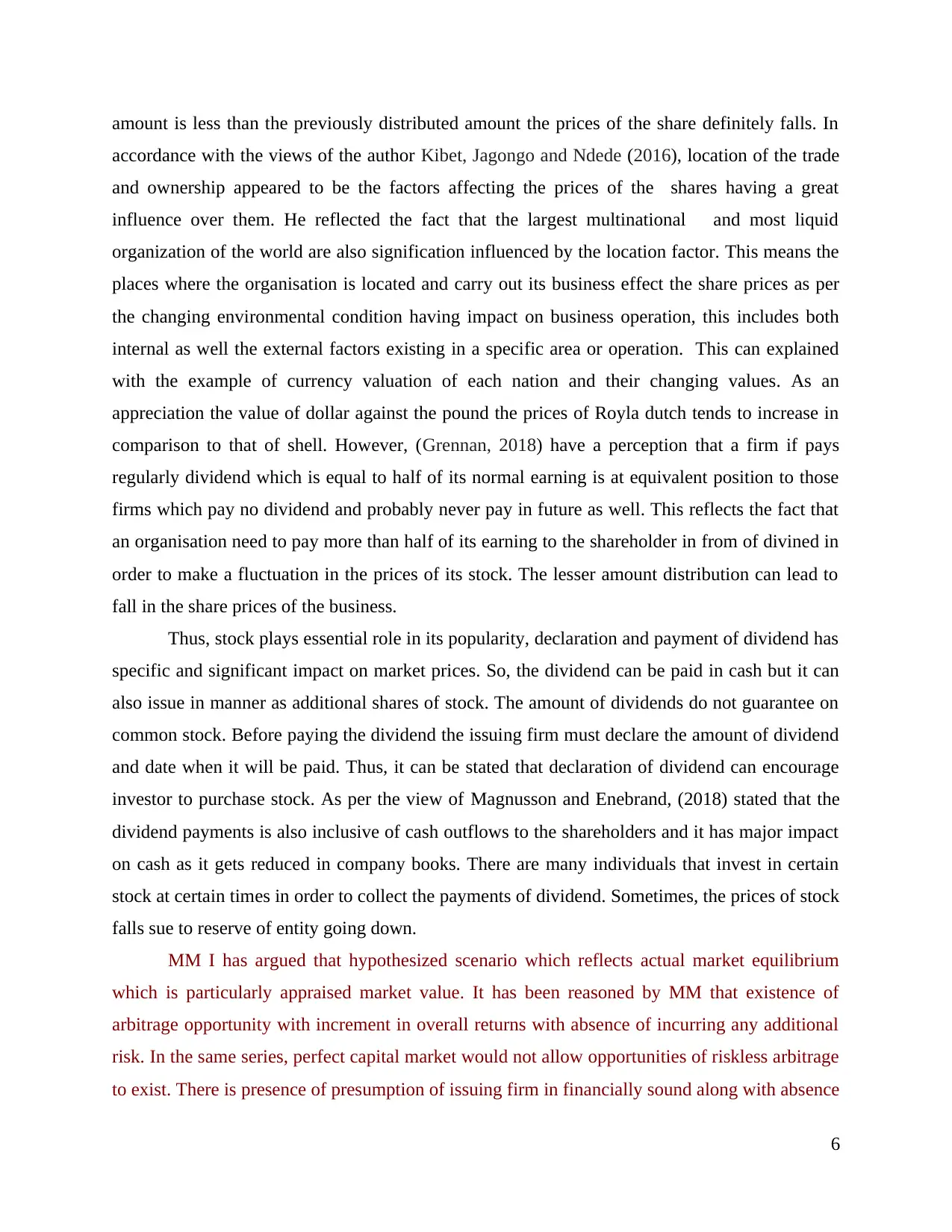
amount is less than the previously distributed amount the prices of the share definitely falls. In
accordance with the views of the author Kibet, Jagongo and Ndede (2016), location of the trade
and ownership appeared to be the factors affecting the prices of the shares having a great
influence over them. He reflected the fact that the largest multinational and most liquid
organization of the world are also signification influenced by the location factor. This means the
places where the organisation is located and carry out its business effect the share prices as per
the changing environmental condition having impact on business operation, this includes both
internal as well the external factors existing in a specific area or operation. This can explained
with the example of currency valuation of each nation and their changing values. As an
appreciation the value of dollar against the pound the prices of Royla dutch tends to increase in
comparison to that of shell. However, (Grennan, 2018) have a perception that a firm if pays
regularly dividend which is equal to half of its normal earning is at equivalent position to those
firms which pay no dividend and probably never pay in future as well. This reflects the fact that
an organisation need to pay more than half of its earning to the shareholder in from of divined in
order to make a fluctuation in the prices of its stock. The lesser amount distribution can lead to
fall in the share prices of the business.
Thus, stock plays essential role in its popularity, declaration and payment of dividend has
specific and significant impact on market prices. So, the dividend can be paid in cash but it can
also issue in manner as additional shares of stock. The amount of dividends do not guarantee on
common stock. Before paying the dividend the issuing firm must declare the amount of dividend
and date when it will be paid. Thus, it can be stated that declaration of dividend can encourage
investor to purchase stock. As per the view of Magnusson and Enebrand, (2018) stated that the
dividend payments is also inclusive of cash outflows to the shareholders and it has major impact
on cash as it gets reduced in company books. There are many individuals that invest in certain
stock at certain times in order to collect the payments of dividend. Sometimes, the prices of stock
falls sue to reserve of entity going down.
MM I has argued that hypothesized scenario which reflects actual market equilibrium
which is particularly appraised market value. It has been reasoned by MM that existence of
arbitrage opportunity with increment in overall returns with absence of incurring any additional
risk. In the same series, perfect capital market would not allow opportunities of riskless arbitrage
to exist. There is presence of presumption of issuing firm in financially sound along with absence
6
accordance with the views of the author Kibet, Jagongo and Ndede (2016), location of the trade
and ownership appeared to be the factors affecting the prices of the shares having a great
influence over them. He reflected the fact that the largest multinational and most liquid
organization of the world are also signification influenced by the location factor. This means the
places where the organisation is located and carry out its business effect the share prices as per
the changing environmental condition having impact on business operation, this includes both
internal as well the external factors existing in a specific area or operation. This can explained
with the example of currency valuation of each nation and their changing values. As an
appreciation the value of dollar against the pound the prices of Royla dutch tends to increase in
comparison to that of shell. However, (Grennan, 2018) have a perception that a firm if pays
regularly dividend which is equal to half of its normal earning is at equivalent position to those
firms which pay no dividend and probably never pay in future as well. This reflects the fact that
an organisation need to pay more than half of its earning to the shareholder in from of divined in
order to make a fluctuation in the prices of its stock. The lesser amount distribution can lead to
fall in the share prices of the business.
Thus, stock plays essential role in its popularity, declaration and payment of dividend has
specific and significant impact on market prices. So, the dividend can be paid in cash but it can
also issue in manner as additional shares of stock. The amount of dividends do not guarantee on
common stock. Before paying the dividend the issuing firm must declare the amount of dividend
and date when it will be paid. Thus, it can be stated that declaration of dividend can encourage
investor to purchase stock. As per the view of Magnusson and Enebrand, (2018) stated that the
dividend payments is also inclusive of cash outflows to the shareholders and it has major impact
on cash as it gets reduced in company books. There are many individuals that invest in certain
stock at certain times in order to collect the payments of dividend. Sometimes, the prices of stock
falls sue to reserve of entity going down.
MM I has argued that hypothesized scenario which reflects actual market equilibrium
which is particularly appraised market value. It has been reasoned by MM that existence of
arbitrage opportunity with increment in overall returns with absence of incurring any additional
risk. In the same series, perfect capital market would not allow opportunities of riskless arbitrage
to exist. There is presence of presumption of issuing firm in financially sound along with absence
6
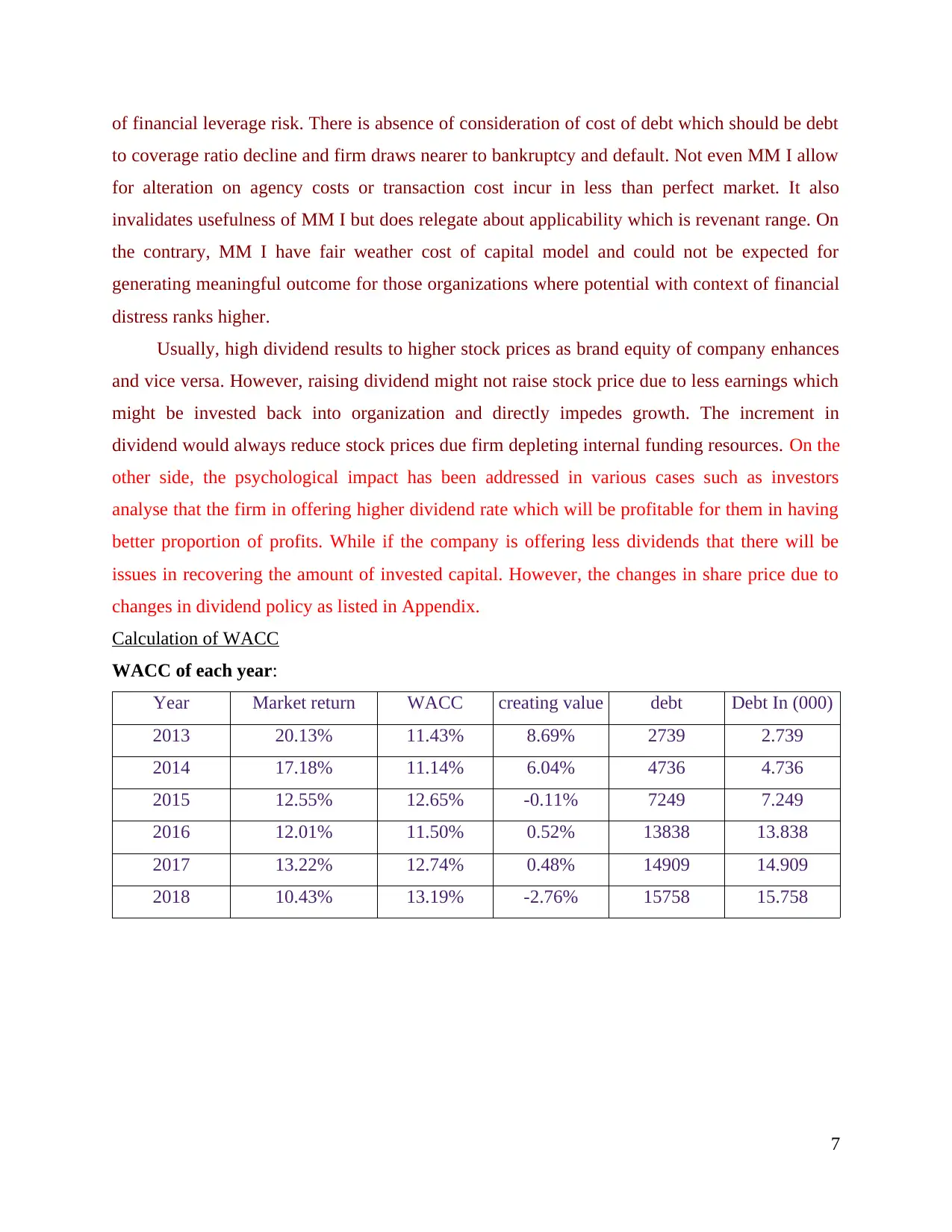
of financial leverage risk. There is absence of consideration of cost of debt which should be debt
to coverage ratio decline and firm draws nearer to bankruptcy and default. Not even MM I allow
for alteration on agency costs or transaction cost incur in less than perfect market. It also
invalidates usefulness of MM I but does relegate about applicability which is revenant range. On
the contrary, MM I have fair weather cost of capital model and could not be expected for
generating meaningful outcome for those organizations where potential with context of financial
distress ranks higher.
Usually, high dividend results to higher stock prices as brand equity of company enhances
and vice versa. However, raising dividend might not raise stock price due to less earnings which
might be invested back into organization and directly impedes growth. The increment in
dividend would always reduce stock prices due firm depleting internal funding resources. On the
other side, the psychological impact has been addressed in various cases such as investors
analyse that the firm in offering higher dividend rate which will be profitable for them in having
better proportion of profits. While if the company is offering less dividends that there will be
issues in recovering the amount of invested capital. However, the changes in share price due to
changes in dividend policy as listed in Appendix.
Calculation of WACC
WACC of each year:
Year Market return WACC creating value debt Debt In (000)
2013 20.13% 11.43% 8.69% 2739 2.739
2014 17.18% 11.14% 6.04% 4736 4.736
2015 12.55% 12.65% -0.11% 7249 7.249
2016 12.01% 11.50% 0.52% 13838 13.838
2017 13.22% 12.74% 0.48% 14909 14.909
2018 10.43% 13.19% -2.76% 15758 15.758
7
to coverage ratio decline and firm draws nearer to bankruptcy and default. Not even MM I allow
for alteration on agency costs or transaction cost incur in less than perfect market. It also
invalidates usefulness of MM I but does relegate about applicability which is revenant range. On
the contrary, MM I have fair weather cost of capital model and could not be expected for
generating meaningful outcome for those organizations where potential with context of financial
distress ranks higher.
Usually, high dividend results to higher stock prices as brand equity of company enhances
and vice versa. However, raising dividend might not raise stock price due to less earnings which
might be invested back into organization and directly impedes growth. The increment in
dividend would always reduce stock prices due firm depleting internal funding resources. On the
other side, the psychological impact has been addressed in various cases such as investors
analyse that the firm in offering higher dividend rate which will be profitable for them in having
better proportion of profits. While if the company is offering less dividends that there will be
issues in recovering the amount of invested capital. However, the changes in share price due to
changes in dividend policy as listed in Appendix.
Calculation of WACC
WACC of each year:
Year Market return WACC creating value debt Debt In (000)
2013 20.13% 11.43% 8.69% 2739 2.739
2014 17.18% 11.14% 6.04% 4736 4.736
2015 12.55% 12.65% -0.11% 7249 7.249
2016 12.01% 11.50% 0.52% 13838 13.838
2017 13.22% 12.74% 0.48% 14909 14.909
2018 10.43% 13.19% -2.76% 15758 15.758
7
⊘ This is a preview!⊘
Do you want full access?
Subscribe today to unlock all pages.

Trusted by 1+ million students worldwide
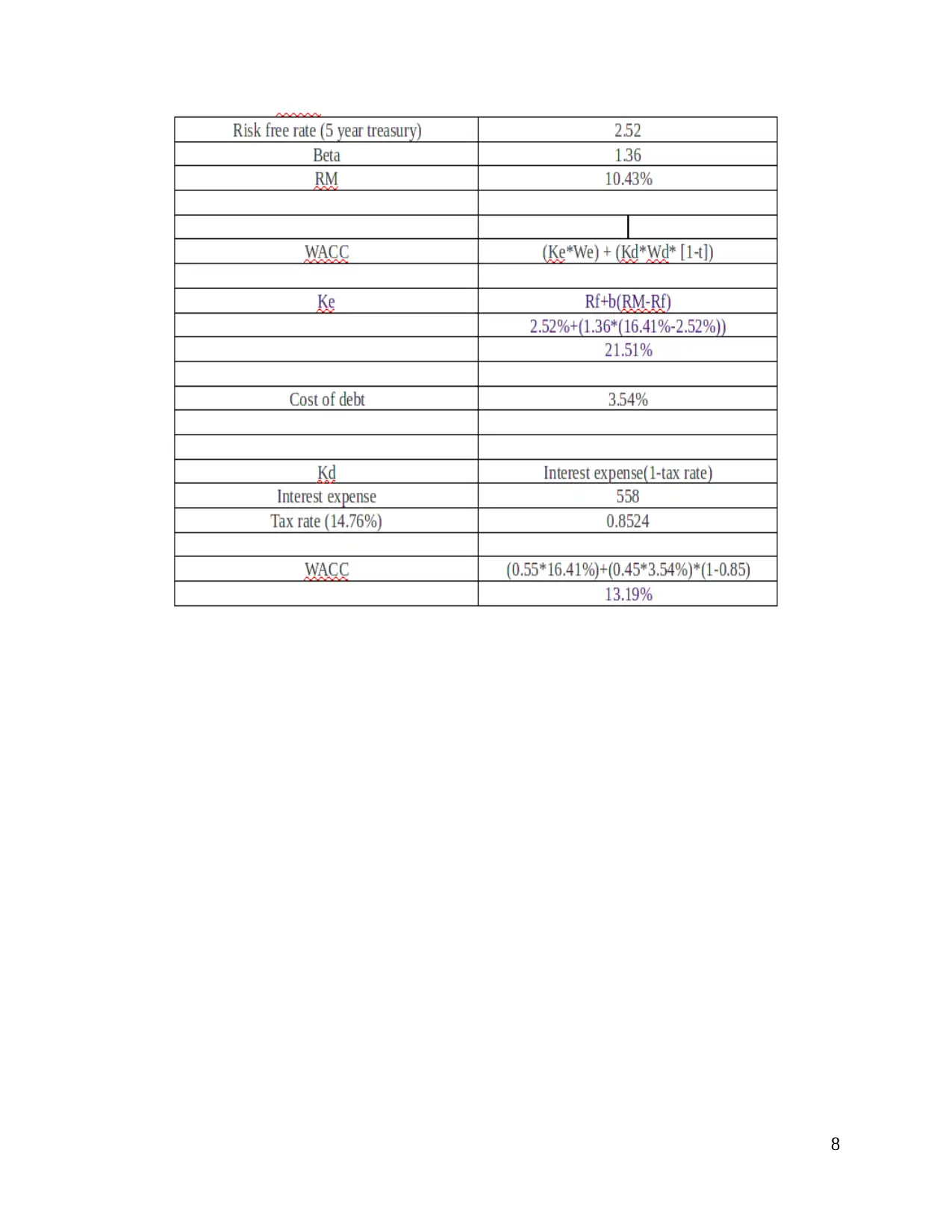
8
Paraphrase This Document
Need a fresh take? Get an instant paraphrase of this document with our AI Paraphraser

Risk free rate: Risk free rate is considered as theoretical rate of return of investment
with zero risk. Generally, it reflects interest of an investor which would expect through an
absolute risk free investment over specified duration of time. In the above scenario, risk free rate
is 5 year treasury bills are considered nearly free of default risk due to fully backed through US
government.
Illustration 3: 5 year treasury rate
(Source: 5 year treasury bill rate, 2019)
Beta Calculation
(Listed in Appendix)
It is replicated as measure of volatility or systematic risk of a single stock comparatively
unsystematic risk of entire market. It is implied in capital asset pricing model which helps in
extracting expected return of asset with use of beta along with expected market returns. In the
above scenario, beta has been extracted by Covariance (Re, Rm)/ Variance (Rm) and Re is
denoted to return on Fedex share price, Rm is denoted to S&P 500 index price. Thus, covariance
of Re and Rm is 0.0013, Variance of S&P 500 is 0.0009. Henceforth, covariance is divided with
variance as its outcome as 1.36 as beta.
Market return (RM)
9
with zero risk. Generally, it reflects interest of an investor which would expect through an
absolute risk free investment over specified duration of time. In the above scenario, risk free rate
is 5 year treasury bills are considered nearly free of default risk due to fully backed through US
government.
Illustration 3: 5 year treasury rate
(Source: 5 year treasury bill rate, 2019)
Beta Calculation
(Listed in Appendix)
It is replicated as measure of volatility or systematic risk of a single stock comparatively
unsystematic risk of entire market. It is implied in capital asset pricing model which helps in
extracting expected return of asset with use of beta along with expected market returns. In the
above scenario, beta has been extracted by Covariance (Re, Rm)/ Variance (Rm) and Re is
denoted to return on Fedex share price, Rm is denoted to S&P 500 index price. Thus, covariance
of Re and Rm is 0.0013, Variance of S&P 500 is 0.0009. Henceforth, covariance is divided with
variance as its outcome as 1.36 as beta.
Market return (RM)
9
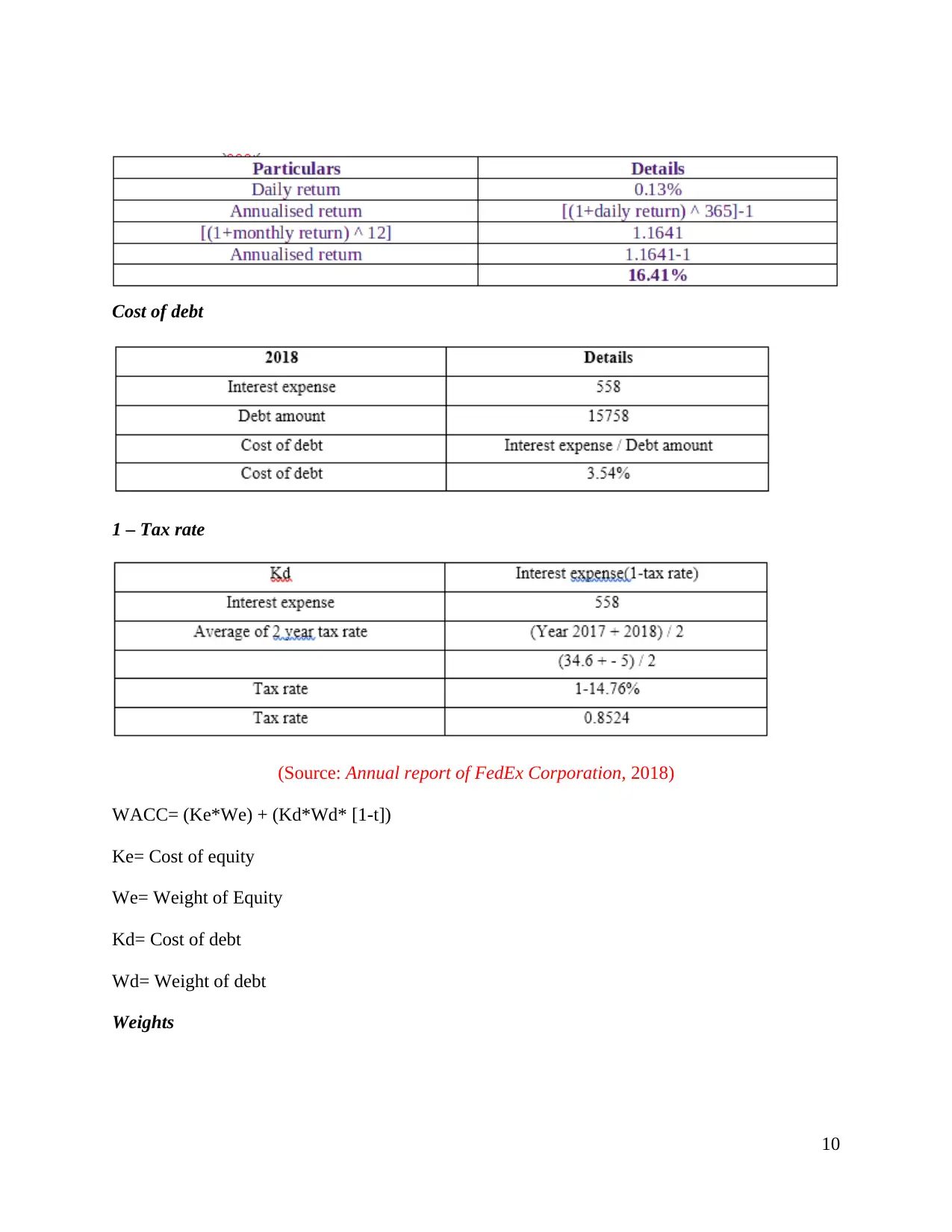
Cost of debt
1 – Tax rate
(Source: Annual report of FedEx Corporation, 2018)
WACC= (Ke*We) + (Kd*Wd* [1-t])
Ke= Cost of equity
We= Weight of Equity
Kd= Cost of debt
Wd= Weight of debt
Weights
10
1 – Tax rate
(Source: Annual report of FedEx Corporation, 2018)
WACC= (Ke*We) + (Kd*Wd* [1-t])
Ke= Cost of equity
We= Weight of Equity
Kd= Cost of debt
Wd= Weight of debt
Weights
10
⊘ This is a preview!⊘
Do you want full access?
Subscribe today to unlock all pages.

Trusted by 1+ million students worldwide
1 out of 28
Related Documents
Your All-in-One AI-Powered Toolkit for Academic Success.
+13062052269
info@desklib.com
Available 24*7 on WhatsApp / Email
![[object Object]](/_next/static/media/star-bottom.7253800d.svg)
Unlock your academic potential
Copyright © 2020–2025 A2Z Services. All Rights Reserved. Developed and managed by ZUCOL.





